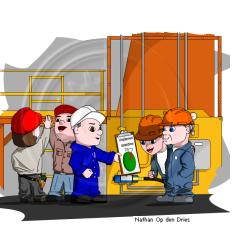
Why all of the interest in tests? Perhaps it is way of asking trainees to appreciate the expenditure and investment being made and to take the training seriously. This motivation is sound enough given the economic conditions under which many companies are operating this year. The written test can be a useful tool for reviewing key content covered in the training and for assessing the transfer of knowledge to a certain level. It also has some obvious limitations. Below are some of my thoughts on the written test.
Written Test Limitations
As a key tool in assessing worker performance the written test has limitations. Here's a few;
1. For many, our early school experiences cause our whole body physiology to change to an extremely nervous state when we're told that we'll have to take a test. I know that I am often in this camp. This factor by itself can influence how effective the training session will be when many of the participants are obsessing with the test to come and worried that they might perform poorly. Are they really in a position to get the most from the training session?
2. A written test that is not well designed for the for the learning styles of the trainee group, turns out to be a test in how well one can take a test. Basic trainee literacy issues can surface at this point as well. Computer hosted tests are notorious for these issues.
3. Tests questions that primarily require factual recall, only test short term memory. Most of us who haven't taken the written component of a driver's test in a few years know that we have forgotten some of the details in the laws that govern traffic and highway use. Many companies use a written test to document their diligence in safety training. But if the training is not refreshed until many months later, are the trainees still knowledgeable on matters of safety?
4. A written test does not clearly indicate what a person can actually do. In the field of applied skills (all of industrial maintenance) it is very important to both 'know' and be able to 'do'.
Five Tips to Get Value from Written Tests
1. Align the test and the training sessions
Make sure that the test is well matched to the content and objectives of the training session. Using questions from a standard test bank or library may make for easy test construction, but the validity of the test will be low. If the training sessions have allowed for a flexible delivery where the specific needs of the trainee have been addressed during the sessions, you may need to modify and edit the test at the last moment to account for a change in content emphasis.
2. Help the class prepare for the test
Let them know well in advance how much of the test requires factual recall and memorization vs. understanding of general principles and concepts. Let them know what resources they'll have access to during the test. Emphasize key test material during the actual training sessions.
3. Use a variety of test item types
An entire test made up of multiple choice and true or false items is easy to mark but a poor indicator of true knowledge retained by the learner. It is important to include test items that allow the trainee to write a short answer in his/her own words (fill in the blank and short answer questions). A test item that asks trainees to match a series of terms to their symbols or definitions is another example of good test item variety.
You might also choose to design an open-book portion of the of the test. This is a test or a portion of a test that asks the trainee to use other resources such as manuals, drawings, schematics and formula tables. In this case you are not asking the trainee to memorize but rather to demonstrate resourcefulness and various technical communication competencies.
You might choose to have some actual physical machine parts and components labeled by letter or number and require the trainees to identify them in writing on the test. This type of item brings the test to near crossover between written and practical evaluation.
4. Review the test together as a group
Once the test is complete, you may choose to grade and review the test in the classroom as a group. If you are concerned about participants changing their answers during this stage you might choose to supply one color of pen during the writing of the test and then collect them and pass out another color for the grading/reviewing stage. The importance of this group review is that as a trainer you get one more chance to reinforce critical concepts and gauge the group's understanding. You also give the trainees a chance to defend their answers, especially the written ones where sole interpretation on the trainer's part is much more difficult.
5. Combine written testing with practical tests
If the results of a written test are to be recorded as a part of an employee's formal performance record, combine the test with other practical assessments. Again, the field of industrial maintenance is about 'know' and 'do'. If a trainee has done well on a written test on the topic of shaft alignment for example, then a planned matching practical evaluation might include observing the trainee make the correct preparations for shaft alignment in the field.
A written test is but one component in an overall evaluation strategy that must include assessment of visible job performance. For those of you who are familiar with Kirkpatrick's training assessment model, this is called a level three, behavior evaluation. Ultimately what you do, and can do is more important than what you supposedly know.
Your thoughts on written tests?
